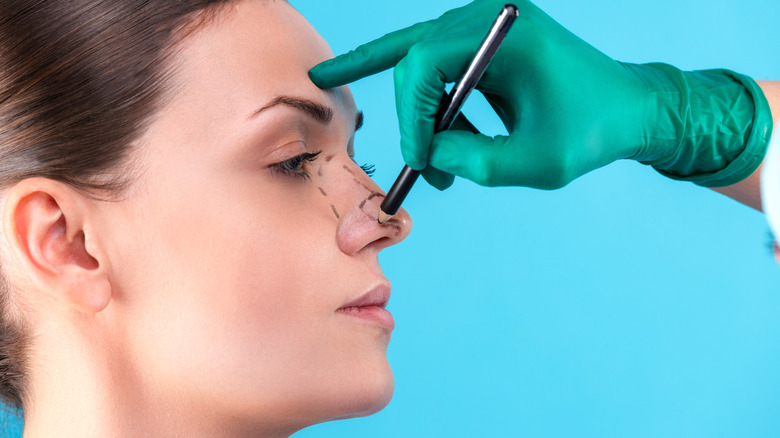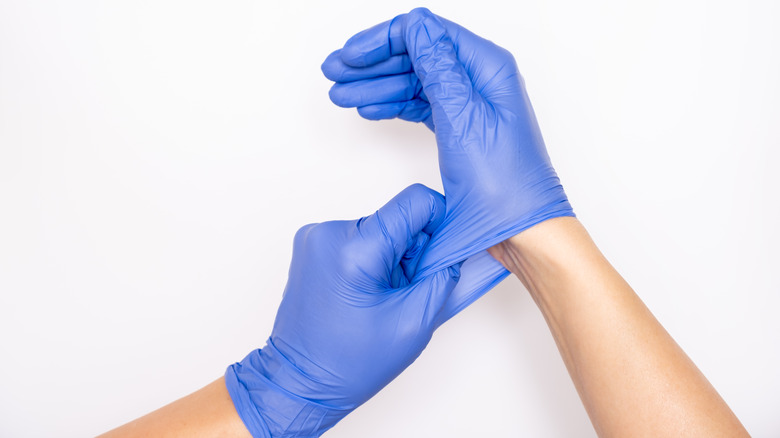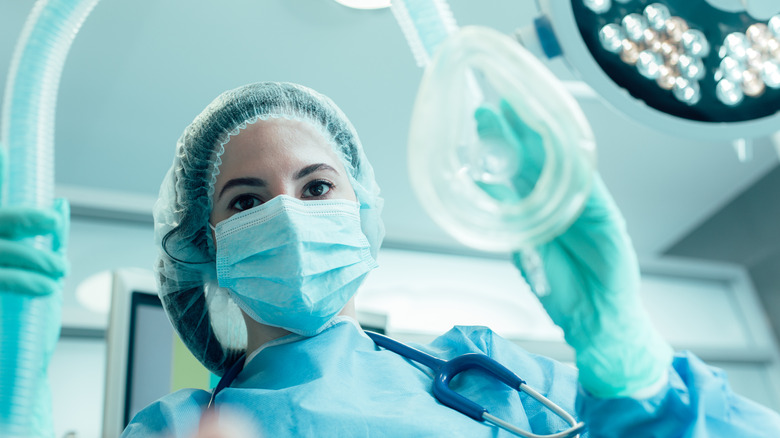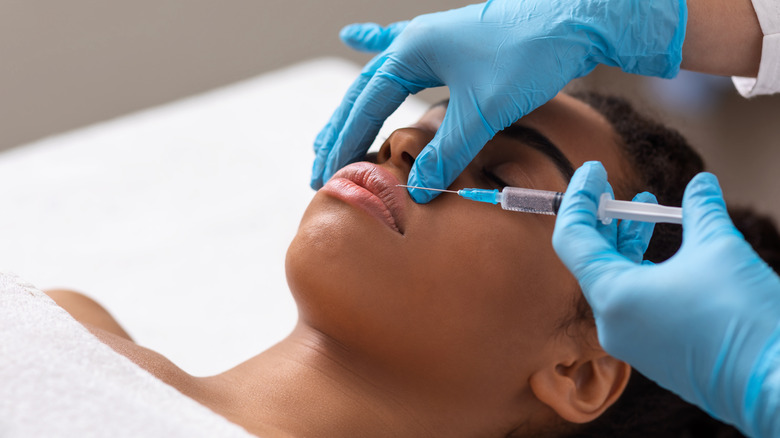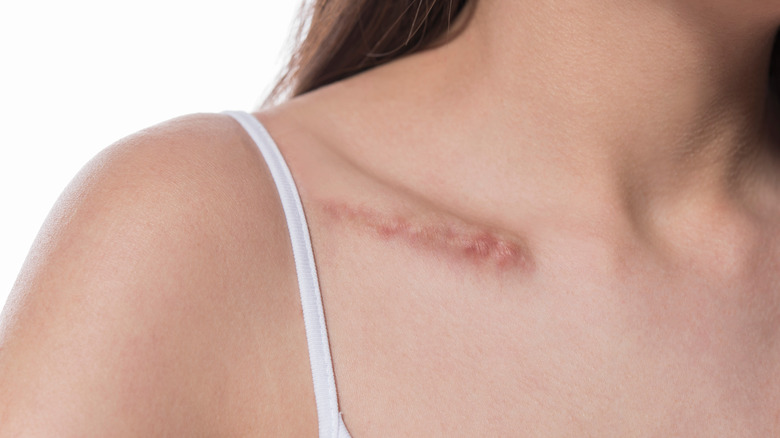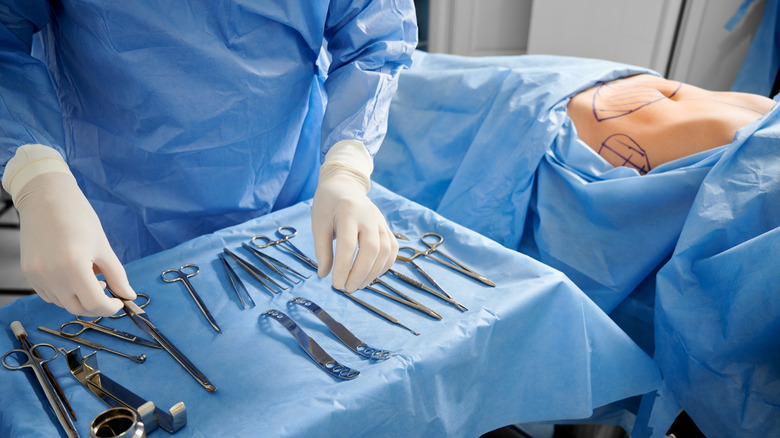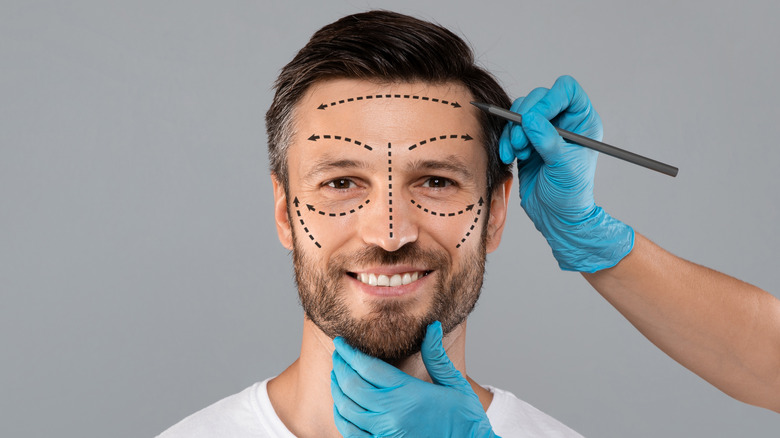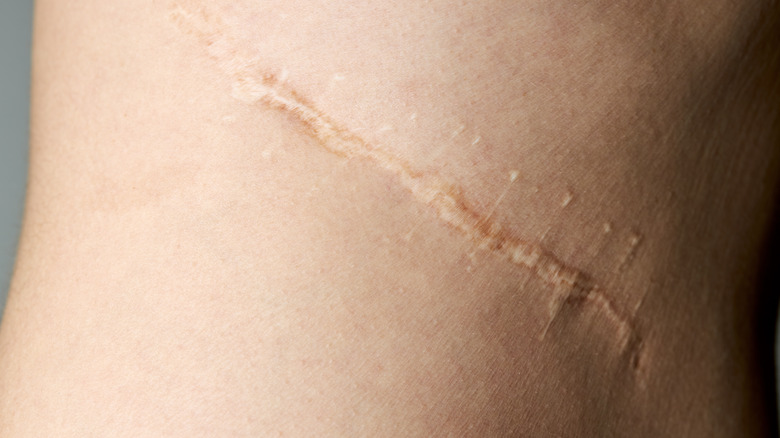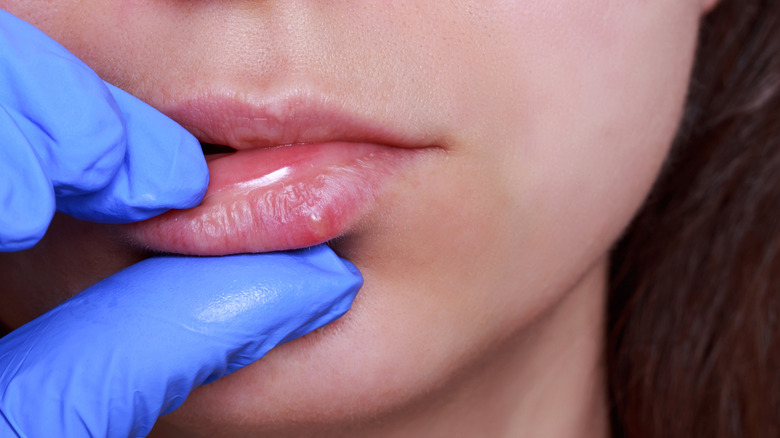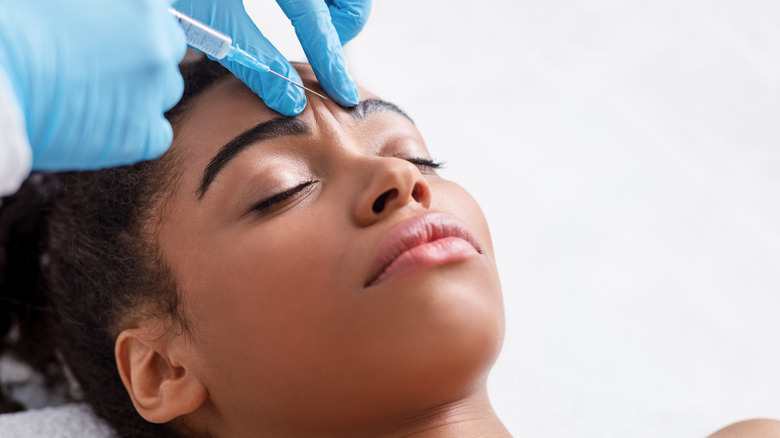Side Effects Of Plastic Surgery You Might Not Know
It seems like plastic surgery is more accessible and popular than ever. Scrolling through social media may make you feel as if "perfection" is just a few needles away, according to a study in Plastic and Reconstructive Surgery. Of course, this isn't true, and rationally, we all know it. That does not stop many from wondering how they'd look with a nose job, breast augmentation, and a few fillers here and there, though.
In 2020 alone, Americans spent $16.7 billion on various cosmetic procedures, according to the American Society of Plastic Surgeons. Though the vast majority of people who undergo cosmetic procedures come out on the other side with no lingering issues, surgery is surgery. And no surgery is inherently risk-free. In fact, there are quite a few things that could go wrong both while under the knife and throughout the healing process.
Curious about plastic surgery but concerned about the risks? Here are some of the most common and surprising side effects of plastic surgery that you may not have considered.
Infections
Infections are a risk of surgery at large and, thus, a risk of plastic surgery. Nurses, doctors, and other hospital staff keep operating rooms sterile, but your best defense against infection is your skin. Once a cut is made, this literally opens your body up to whatever may be lurking in the outside world (via Verywell Health).
Plastic surgery infections can potentially change the outward appearance of the work you had done, ultimately leaving you with a more visible scar in the area you had wanted to address. "And in the case of a surgery that involves an implant, such as breast augmentation or chin augmentation, if an infection manages to spread from the incision to the implant, the implant may have to be removed," Verywell Health explained.
However, the risk of infection after plastic surgery is low at about 1%, with some populations sitting at slightly elevated risk compared to others. If you've recently had plastic surgery and suspect you may have an infection, it is important to notify your doctor right away. Some of the earliest signs of infection include pain or redness at the incision site, foul odor or discharge at the incision site, or a fever greater than 101.5 degrees Fahrenheit.
Adverse reactions to anesthesia
The Mayo Clinic stresses the need to "understand the medical risks" before undergoing any cosmetic procedure. This includes learning about the risks of anesthesia. Frustratingly, anesthesia is tricky. It is often used, but the effects of the substances are not fully and thoroughly understood. Basically, anesthesia places patients in a medically induced coma to be unresponsive and free of pain during surgical procedures. When administered under proper guidance and care, anesthesia is generally thought to be safe, with only one in every 100,000 to 200,000 resulting in death.
However, some people can react poorly without having life-threatening consequences due to anesthesia. Some of the most common adverse side effects include dizziness, trouble urinating, nausea, vomiting, temporary memory loss, and shivering or feeling cold. Most of these side effects dissipate after the anesthesia gets processed through your system. The people who run the highest risk of experiencing adverse reactions due to anesthesia include people with high blood pressure, sleep apnea, diabetes, obesity, and alcoholism. People who smoke, have a history of drug allergies, or have existing heart and lung conditions also run a slightly increased risk of experiencing complications (via Medical News Today).
Granulomas
Soft tissue fillers, chemical peels, laser hair removal, microdermabrasion, and botulinum toxin (Botox) injections fall under the umbrella of cosmetic procedures and thus carry some risks. However, they are considered minimally invasive.
A study published in the Journal of Cutaneous and Aesthetic Surgery revealed that there was about a 12% decline in invasive cosmetic procedures between 2000 and 2014. Conversely, there was a 154% increase in minimally invasive procedures administered during this timeframe. With the rise in these services also came a rise in the incidence of granulomas, which at their core are small areas of inflammation in the body. They tend to be noncancerous and are thought to be a part of immune function. They help trigger the body to ward off foreign invaders (via Mayo Clinic). While the occurrence of granulomas has increased, experts say that they are generally more common in patients who've had procedures done at salons and spas compared to in doctors' offices.
If you are thinking of undergoing any of these minimally invasive procedures, you should first consult a well-trained medical professional. Ensuring that you are receiving your fillers, injections, and the like in a sterile environment is one way to help prevent the occurrence of granulomas. However, they can still occur, per the study.
Scarring
Scarring is a common side effect of most surgical procedures. However, plastic surgeons tend to emphasize creating smaller, less-noticeable scars, which can help the overall aesthetic they are trying to achieve (via ShareCare). The way many plastic surgeons are able to hide scars is basically wizardry. Still, even the most incredible surgeons still have to make an incision to perform a surgery, which is guaranteed to leave a mark.
An infection at the incision site can lead to more noticeable scarring, but that infection is not the only cause. Some people are predisposed to keloid scars, which occurs when scar tissue grows out of control. This can result in a much bigger scar than the original incision (via Healthline).
One of the best ways to manage a scar is to begin massaging it as soon as you have passed the initial stages of healing. This can help break up the scar tissue and leave your skin with a less noticeable blemish. If you begin to notice that your incision site is not healing properly or is showing signs of infection, call your plastic surgeon right away (via Memphis Plastic Surgery Group).
Hematomas
Hematomas essentially present as bruises on steroids. Though the presentation mechanism is slightly different, hematomas can be viewed as severe and dark bruising. They are one of the most frequently experienced side effects following cosmetic surgery. However, they tend to be a more mild side effect than many others. In a study conducted and published by the Aesthetic Surgery Journal, researchers discovered that only about 1% of the nearly 130,000 cosmetic surgery patients experienced a "major" hematoma following plastic surgery.
In this study, researchers determined that men are more likely than women to experience hematomas after a procedure. They discovered that patients who underwent a single procedure at one time had a reduced risk of hematoma development than those who had multiple procedures performed. Hematomas were more likely after breast procedures as opposed to surgeries on the face or extremities. Additionally, the older the patient, the higher the risk of hematoma development.
Blood clots
Blood clots can be fatal, yet many patients are not given a blood clot risk assessment before receiving their cosmetic surgeries, according to the University of Michigan Health System (via Science Daily). As many as one in nine plastic surgery patients could develop clots if not given clot-preventing medications right after surgery. Past studies have shown that some plastic and reconstructive surgery patients are at elevated risk of clotting. Yet, only about 50% of plastic surgeons administer clot-preventing drugs following surgery.
The risk factors for developing clots include pregnancy, cancer, obesity, oral contraception use, and a family history of blood clots. After the surgery occurs, many new risk factors are brought to the surface. These include how many surgeries were performed at one time, immobility, trauma, and central catheters. Some patients are at risk of developing deep vein thrombosis, which is a blood clot deep within the arteries of the leg. This condition can turn into a deadly pulmonary embolism incredibly quickly (via Science Daily). Check in with your doctor about your risks before scheduling your surgery.
Nerve damage
Nerve damage actually occurs every time surgery is performed, according to Verywell Health. When surgery is performed properly and heals as intended, the low-grade nerve damage that occurs at the incision site eventually becomes almost imperceptible after enough time has passed. However, nerve damage can exceed what's considered typical. "Injury occurs if nerves are stretched, cut, or cauterized," explained the publication. Afterward, you may experience a pins and needles sensation, or symptoms that range all the way up the spectrum to muscular paralysis. It can take years for a complete recovery, or the damage may be permanent.
Even some of the most popular cosmetic procedures can cause nerve damage. For example, a forehead or brow lift can inhibit the motion in the forehead, scalp, and eyelids. A rhinoplasty, or nose job, can end in numbness of the nasal skin. Breast augmentation can potentially lead to decreased sensations through the nipples and numbness over the breast and surrounding skin.
That is to say, plastic surgery does not come without risks. It's best to weigh the pros and cons before opting for an elective surgery that may cause acute or semi-chronic nerve damage.
Separation at the incision site
Separation at the incision site after surgery, also known as "dehiscence," occurs when the two sides of the wound begin to pull away from each other (via Verywell Health). Typically, a well-healing wound will have neat edges held together by sutures. During the first few weeks of healing, the tissues at the surgical site will begin to regenerate. As they grow back, they are less mature and thus not as strong as the well-developed tissues. If a suture gives way for whatever reason (a cough, sneeze, twist in the wrong direction), the wound may be at risk of dehiscence. If at any point you notice wound separation, you should seek medical attention. Even a small separation is worth contacting your doctor about because it can lead to evisceration, which Verywell Health described as "a very serious complication where the organs begin to push outside of the open incision."
Wound dehiscence is, thankfully, a rare side effect of plastic surgery. Still, it does happen to about 0.75% of people who undergo plastic surgery, according to a study published in Plastic and Reconstructive Surgery. Researchers determined that age is not a risk factor for incision site separation, which is helpful to note if you are considering plastic surgery at a more advanced age.
Excessive bleeding
You can lose a whole bunch of blood before you start to feel any of the effects. Of course, it is not advised that you lose a lot of blood at one time — you know this. Plastic surgery is similar to all other surgeries in that some amount of blood loss is necessary and expected. After all, the first thing your body does when cut is bleed. Uncontrolled blood loss can lead to a dramatic loss in blood pressure that can have potentially deadly outcomes. "Fortunately, in most plastic surgery procedures, the risk of large-volume blood loss is generally low," confirmed the University of Pittsburgh Medical Center.
Arguably more frightening is the potential for internal bleeding following an operation. You cannot see nor easily diagnose internal bleeding, making it that much more insidious. One recognizable sign of internal bleeding is dark, bloody vomit or stool. Aside from that, symptoms include dizziness, weakness, passing out, low blood pressure, vision changes, unilateral weakness, severe abdominal pain, and chest pain (via Healthline).
Anaphylaxis and other adverse reactions
Many soft tissue fillers are derived from hyaluronic acid, which naturally occurs in the body, and are well tolerated by most people, according to the University of California, San Francisco. The main side effects of these types of fillers can be rectified and healed with the application of ice. However, some acute and dramatic adverse reactions have been recorded. In very rare cases, patients have been reported to go into anaphylaxis, according to the FDA.
As more and more people seek out dermal fillers as accessible forms of minimally invasive cosmetic procedures, the likelihood of poor reactions increases due to the sheer number of people receiving them. In recent years, doctors have become more adept at preventing adverse reactions. The most serious reactions to fillers can be generally avoided by the person injecting them, taking special care to avoid blood vessels, according to a study in the Journal of Clinical and Aesthetic Dermatology.
Many of the awful reactions recorded as a result of fillers were those that were administered by untrained individuals. However, even under optimal conditions and a skillful, precise hand, your body may end up reacting poorly in a way that results in scarring, pain, and abscesses.
Seromas
Seromas are formed when a collection of sterile bodily fluid, or serum, collects beneath the surface of the skin and results in swelling and sometimes pain (via Healthline). Post-surgery, seromas typically pop up near the surgical site or where tissues were removed. Though seroma formation can happen after any surgery, it is a very common side effect of tummy tucks, in particular. In fact, about 15 to 30% of all patients who undergo this procedure will experience a seroma (via Healthline).
If left untreated, seromas can result in an infection, making it paramount to receive medical attention at the first notice of such an occurrence. Seromas are most typically drained by a needle, but they can often reoccur. The formation of seromas does not begin to occur until a week or two weeks after surgery, and aside from tummy tucks, they are most common in patients who have undergone extensive surgeries, according to Healthline. Your surgical team will often place drainage tubes around the surgical site to help drain the serum and prevent the likelihood of a seroma formation.
Vascular occlusion and blindness
Although minimally invasive procedures tend to have more mild side effects than more invasive surgeries, that's not always the case. Vascular occlusion is a rare side effect of facial fillers. This can lead to blindness, according to a study in Plastic and Reconstructive Surgery.
This occurs when the contents of the injection blocks a blood vessel that supplies blood to the eye. Cases of irreversible blindness have been reported in Asia, North America, and Europe. Researchers determined that autologous fat (i.e., a fat injection) is the most common cause, according to the study. In some cases, partial vision has been restored through calcium hydroxylapatite fillers and hyaluronic acid injections.
Researchers have expressed concern about the newer fillers that are available, especially if they are injected by inexperienced personnel. Newer injectors might be less familiar with the "variations in the pattern of facial vascular arborization," which is essentially the vascular structure of the face, the study explained.
Organ damage
Organ damage is a liposuction-specific side effect (via Healthline). Liposuction, often called body contouring, is fairly mainstream in plastic surgery. Typically, it is employed when an individual has difficulty losing body fat in specific areas. Still, it is not a weight loss surgery. The risks of liposuction are quite serious and should be discussed at length before scheduling an appointment.
Some of the major side effects of liposuction include puncture wounds, organ injuries, nerve damage, burns, shock, and even death, according to Healthline. Liposuction can pose a threat to the abdominal organs, including the liver and intestines, as well as the lungs. If a liposuction tool punctures the intestines and it is not caught, an infection could quickly become systemic and result in death. When liposuction is performed under local anesthesia, perforation of the intestines would immediately cause extreme pain, which would lead to a quicker diagnosis. Under general anesthesia, though, an injury might not be detected by the surgeon or patient until it's far too late (via Liposuction).

